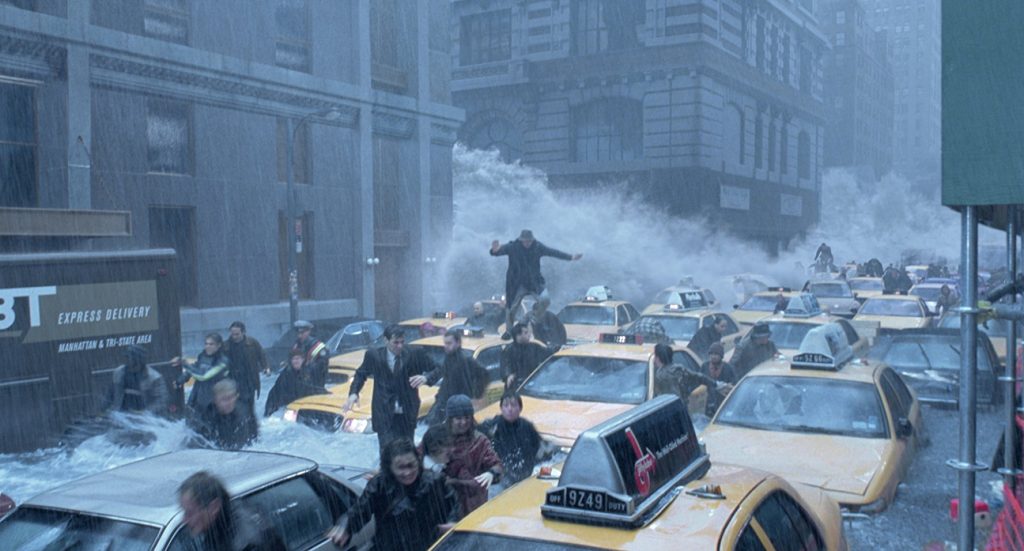The Day After Tomorrow (2004)

Some people have been calling The Day After Tomorrow a throwback to the Irwin Allen disaster films of the 1970s, but in reality, it is more of a throwback to the disaster films of the 1990s). Whereas Allen’s films were primarily epic tales of human valor in the face of certain calamity, the new crop of disaster films are meant merely as a showcase of mind-blowing, earth-shattering special effects first, while the little stories of personal peril are merely filler to tie together the prolonged scenes of mass destruction. This is familiar territory for writer-director Roland Emmerich, who has made a couple of notable films featuring the destruction of major cities with Godzilla and Independence Day. These kinds of films are completely reliant on formula theatrics, to begin with — The Day After Tomorrow‘s downfall is that it is little more than Emmerich cannibalizing his own already plagiarized ideas in an attempt to deliver box office gold once again.
The plotline involves a supposition that the global warming apocalypse that many scientists have been predicted is finally here, and in an accelerated example of such disastrous events, much of the Earth’s northern hemisphere suffers from severe flooding, tidal waves and an ice storm that threatens to wipe out practically all life as we know it in those affected regions. Climatologist Jack Hall (Quaid), one of the main proponents of the coming ice age theory, must try to convince the government that imminent danger is here for all of them, but the warnings fall mostly on deaf ears. Then, the unthinkable happens, with tornados ripping through Los Angeles, and water flooding through Manhattan and all the world must take notice.
The only compelling aspect of The Day After Tomorrow comes from the handful of scenes that depict the total destruction of some of the United States’ largest cities, and more specifically, their most popular landmarks. As impressively as these scenes are rendered, this is still Emmerich at his most brain-dead, giving us the same feelings of “shock and awe” that he did so memorably in ID4, and these scenes aren’t just the eye-candy moments for a big budget movie — they are the movie’s only reason to exist. No doubt Emmerich said when conceiving this movie, “I want to show big scenes of mass chaos and devastation to New York and the national monuments, and will use the global warming premise as a means to make everyone flock to my movies once again to have a front-row seat to the deaths of millions of people for their viewing pleasure.”
The trouble with The Day After Tomorrow isn’t that Emmerich skimps out on mouth-agape action, because those scenes of Manhattan and Los Angeles being annihilated by the most extreme weather conditions are truly compelling — the problem is that all of the reasons to see this film are already featured in the trailer. What you don’t see in the trailer is what constitutes the other 75% of the film, namely, the highly predictable brother-helping-brother side stories of families and strangers coming together in their time of great need, and all of the usual wafer-thin archetypical characters you expect in an ensemble film such as this. If you’ve seen one disaster flick, you really have seen them all, and The Day After Tomorrow‘s redundancy in the character development stage makes the non-disaster scenes intrinsically monotonous.
A common gripe of mine is that there seems to be a rule of thumb when it comes to summer blockbusters that the bigger the budget for special effects, the smaller the development in quality writing, and just like most of the Emmerich-penned productions, the main weakness is the script itself. The dialogue and situations are so ludicrous, that only a self-aware, campy delivery could possibly have made them palatable. Yet everything is played completely straight, without the merest trace of a smirk, save for some occasionally ironic situations that provide welcome comic relief.
Unless you have a hard-on for massive devastation and cheesy heroics, you’d probably save yourself a little money and a lot of time by just watching the promotional advertisements for The Day After Tomorrow instead. There’s literally nothing else going for the film unless you really need to see and hear all of the carnage on the big screen in seat-rumbling surround sound. It’s an illogical, ill-conceived insult to one’s intelligence so complete that the message of warning about the possibilities of what it will be like in the figurative “Day After Tomorrow” doesn’t compare to the hangover of the morning after when viewing such a relentless assault on the brain of similarly colossal proportions.
Qwipster’s rating: C-
MPAA Rated: PG-13 for intense situations of peril
Running Time: 124 min.
Cast: Dennis Quaid, Jake Gyllenhaal, Emmy Rossum, Dash Mihok, Jay O. Sanders, Sela Ward, Austin Nichols, Arjay Smith, Tamlyn Tomita, Sasha Roiz, Ian Holm, Nassim Sharara, Carl Alacchi, Kenneth Welsh, Adrian Lester, Nestor Serrano
Director: Roland Emmerich
Screenplay: Roland Emmerich, Jeffrey Nachmanoff
